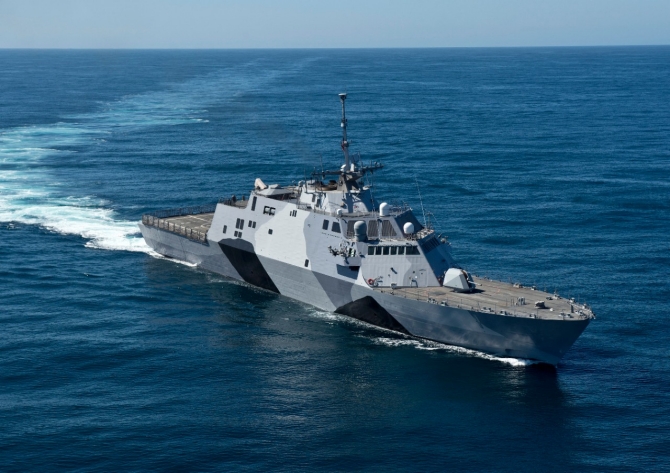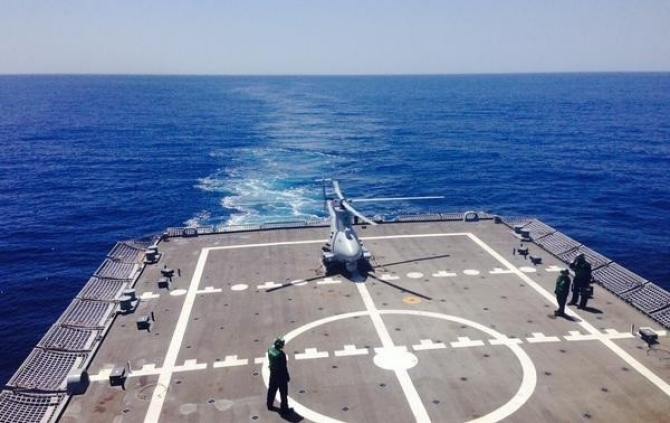Freedom III (LCS-1)
2008-2022
The name of the ship acknowledges the enduring foundation of the United States and honors American communities from coast to coast which bear the name Freedom. States having towns named Freedom range from New York to California, and include Indiana, Maine, New Hampshire, Oklahoma, Pennsylvania, Wisconsin, and Wyoming.
III
(LCS-1: displacement 3,450; length 387.6'; beam 57.7'; draft 14.1'; speed 40+ knots; complement 45+ augmentees that can include an aviation detachment, maritime security mission package, and a Coast Guard law enforcement detachment; armament 1 Mk 110 57 millimeter gun, RIM-116 Rolling Airframe Missile (RAM), 2 Mk 44 30 millimeter Bushmaster II guns, and 4 .50 caliber machine guns; aircraft 1 Sikorsky MH-60R/S Seahawk and 1 Northrop Grumman MQ-8B Fire Scout; class Freedom)
The third Freedom (LCS-1) was laid down on 2 June 2005 at Marinette, Wisc., by Marinette Marine Corp. (Lockheed Martin); launched on 23 September 2006; sponsored by Mrs. Birgit Smith, widow of the late Sgt. 1st Class Paul R. Smith, USA; and commissioned at Veteran’s Memorial Park, Milwaukee, Wisc., on 8 November 2008, Cmdr. Donald D. Gabrielson (Blue Crew), and Cmdr. Michael P. Doran (Gold Crew), in command.
Nine Sailors can operate Freedom in normal underway conditions. “Freedom is not an evolutionary but revolutionary ship in the next generation of warships,” Cmdr. Doran, commanding officer Gold Crew, explained in 2008. “Forty percent of the ship is open and available to complete whatever mission is available at the moment. We simply need the mission package, not an entire new ship.” Freedom has the ability to change out her mission packages in less than 24 hours. She can: accelerate from 0 to 40+ knots in less than two minutes; decelerate from 40+ to 0 knots in approximately three ship lengths; and move directly sideways at 1 knot.
Freedom made her maiden deployment to the Caribbean and Eastern Pacific via the Panama Canal when the ship shifted her home port from Mayport, Fla., to San Diego, Calif. (16 February–23 April 2010). A Littoral Combat Ship Surface Warfare Mission Package, a Sikorsky MH-60S Seahawk of Helicopter Sea Combat Squadron (HSC) 22 Detachment 2, and a Coast Guard LEDET, embarked. Freedom conducted the ship’s first drug seizure when she disrupted a go-fast and recovered more than a quarter ton of cocaine, off the Columbian coast on 22 February. During the voyage the ship made four narcotics interceptions comprising over five and a quarter tons of cocaine and 13 smugglers. The ship accomplished her first integrated at-sea operations when she exercised with aircraft carrier Carl Vinson (CVN-70) in southern Californian waters, on 7 April.

The littoral combat ship, with Surface Warfare Detachment 1 and an MH-60R of Helicopter Maritime Strike Squadron (HSM) 73 Combat Element 1 embarked, completed her maiden overseas deployment when Freedom sailed to the Western Pacific (1 March–23 December 2013). Freedom began the voyage with her Gold Crew (originally designated Crew 102), Cmdr. Timothy B. Wilke in command, but the sailors “swapped” with the Blue Crew (Crew 101), Cmdr. Patrick C. Thien, at Sembawang, Singapore (26 July–8 August), that then sailed the ship on her return home. Both crews numbered 53 sailors because of reinforcements; however, at one point, 82 sailors manned the ship because of the Gold Crew, mission augmentees, and the aviation detachment.
Freedom sailed from the Third Fleet’s area of responsibility and reached the Seventh Fleet on 15 March, where she accomplished primarily theater security cooperation and maritime presence operations. Secretary of the Navy Raymond E. Mabus Jr., visited Freedom while she completed maintenance at Changi on 11 May, and on 27 July, Vice President Joseph R. Biden Jr., visited the ship at Changi.
She took part in Cooperation Afloat Readiness and Training (CARAT) 2013, a multi-threat exercise also involving Bangladesh, Brunei, Cambodia, Indonesia, Malaysia, the Philippines, Singapore, Thailand, and Timor-Leste, as part of Task Group (TG) 73.1 (15–23 June). Commander Destroyer Squadron 7 broke his flag in guided missile destroyer Curtis Wilbur (DDG-54), and TG 73.1 also comprised: dock landing ship Tortuga (LSD-46), with India Company, 3rd Battalion, 3rd Marines embarked; Military Sealift Command (MSC)-manned salvage ship Safeguard (T-ARS-50), with Mobile Diving and Salvage Unit 1 embarked; Lockheed P-3C Orions of Patrol Squadron (VP) 26; Seabees from Naval Mobile Construction Battalion 5; medical professionals and visit, board, search and seizure evaluators from Maritime Civil Affairs and Security Training Command; and Orient Express, the Seventh Fleet’s band. A Malaysian Navy Westland Super Lynx Mk.100 conducted flight deck qualifications on board the ship on 18 June.
Super Typhoon Haiyan/Yolanda cut a wide swath of destruction across the Central Philippines, killing at least 6,268 people (6–9 November 2013). Multiple U.S. ships including Freedom and aircraft raced to the Philippines during Operation Damayan — humanitarian assistance to the victims of the disaster. Freedom’s MH-60R Seahawk, supplemented by another Seahawk flying from guided missile cruiser Cowpens (CG-63), delivered relief supplies to people from a position 16 nautical miles off shore. American and Filipino servicemembers and civil aid workers unloaded ten pallets (five of medical and five of hygienic supplies) at Daniel Z. Romualdez Airport at Tacloban, Leyte. The victims of the tragedy -- as well as the aid workers -- desperately needed the supplies, especially hand sanitizer, baby wash, bandaids, and disinfectant.
Freedom also visited: Pearl Harbor, Hi. (11–14 March); Guam (29 March–3 April); Philippines (9–13 April); Brunei (18 November — where she refueled and loaded supplies for Damayan); Singapore (18 April–11 June, 4–19 July and 31 July–8 August, and 16 November — she shifted berths to Changi Naval Base on 6 May); and Kuantan, Malaysia (15–18 and 22–23 June).
Freedom was stricken from the Naval Vessel Register on 15 September 2022.


Detailed history pending.
Mark L. Evans
5 February 2018
Updated 14 October 2022


